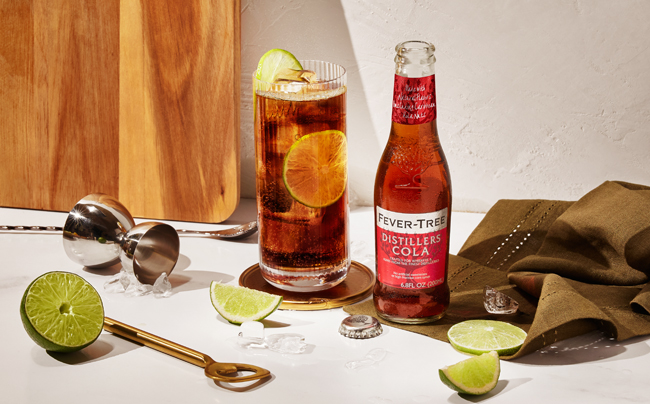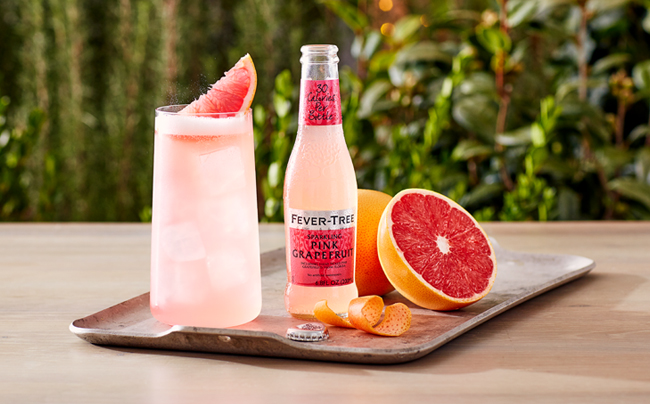As the cocktail mixer category sees renewed growth with the rise of at-home alcohol consumption, U.K.-based premium brand Fever-Tree is feeling the buzz.
The company reported U.S. revenue growth of 42% on a constant currency basis in the first half of 2021, with on-premise sales rebounding rapidly following last year’s channel shutdown. Retail sales in the first six months grew 17% and were up over 100% when compared to 2019. According to Fever-Tree North America CEO Charles Gibb, the strong performance comes as retailers pay more attention to the mixer space and the company is now aiming to capitalize on strong category trends to cement itself as a leader in the premium set.
“More and more people are buying into this concept of premium mixers,” Gibb said. “So [retailers are] giving us more and more shelf space, they’re giving us more visibility in store, they’re giving us more promotional activity, because they’re realizing this is a category that actually makes them a decent margin.”
Founded in 2004, Fever-Tree opened its first U.S. headquarters in Brooklyn, New York in 2018, which assumed direct control over all stateside operations. Since then, with the pandemic charging up at-home cocktail consumption, the mixer category has seen double digit growth (up about 35.4% last year per SPINS) and has been the target of new premium innovations from brands like AVEC, Fullbar and Health-Ade. For Fever-Tree, the company now aims to stay ahead of the curve on evolving tastes through new innovations.
Last year, the brand introduced Sparkling Pink Grapefruit and had planned a robust marketing campaign around the launch, but quickly had to pivot its trade-focused strategy towards digital and social campaigns when the pandemic began and turned to partnerships with bartenders to educate consumers on cocktails they could make in quarantine as a means of promoting the new product.
Now, Fever-Tree has announced two more additions to its lineup: Distiller’s Cola and Sparkling Lime & Yuzu Soda. According to Gibb, the new flavors are based on sales trends showing U.S. consumers gravitating towards premium liquors. Distiller’s Cola is intended to be mixed with top shelf whiskeys as a cleaner alternative to mainstream colas and will have limited distribution, while Lime & Yuzu is best paired with tequila and aimed at a broader consumer base.
“Clearly the rise and rise and rise of tequila has been very well documented, so we look at things that are going to mix well with tequila,” he said. “We look at trends around lower calorie drinking, authenticity and provenance, so being able to take limes and add in this Fever-Tree twist of the yuzu gives us the ideal mixer to go with tequila.”
As consumers increasingly embrace “sober curious” lifestyles that see them reducing their alcohol intake, Gibb said Fever-Tree has also focused on positioning its products for use in mocktails and anytime use. The company has been a regular partner of non-alc spirit alternative maker Seedlip for marketing campaigns built around the two most popular months for consumers to put a pause on drinking: Dry January and Sober October. However, even as the “sober curious” trend grows, Gibb said it’s still in its infancy.
“I would say it’s still more seasonal than anything else and people take those specific timeouts,” he said. “But there’s still that underlying growth of that [non-alc] category, which is undoubtedly going to mature over the next few years.”
Fever-Tree is still playing both sides, however, also partnering with spirits brands like Grey Goose, Jim Beam, Bombay and BACARDI. Gibb noted that the growth of brand partnerships has come in large part through Florida-based distributor Southern Glazer’s Wine & Spirits, the largest independent alcohol wholesaler in the country.
The brand is also looking to expand its nationwide footprint in on-premise and retail. Fever-Tree is currently in about 24,000 bars and restaurants across the country and most recently Fever-Tree added Publix, Walmart and Safeway stores and remains most focused on the grocery and liquor channels, Gibb said. He noted that with last year’s lockdowns limiting consumers’ out-of-home trips primarily to liquor stores, grocery stores and pharmacies, Fever-Tree shifted much of its field marketing towards the liquor channel last year, but now the company sees an opportunity to go deeper within grocery.
“What we’re looking to do in those environments is to expand the range,” he said. “Because as this category gets more and more traction, it becomes more and more relevant for the retailer. And of course, because it’s higher value, this is a way for retailers to improve and to enhance their profitability with this brand driving category growth.”

